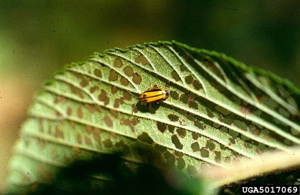DACF Home → Bureaus & Programs → Maine Forest Service → Forest Health & Monitoring → Forest Pest Index → Elm Leaf Beetle
ELM LEAF BEETLE
Pyrrhalta luteola (Muller)

Photo: Pennsylvania Department of Conservation and Natural Resources - Forestry Archives, Pennsylvania Department of Conservation and Natural Resources, Bugwood.org
Symptoms and Damage
Adults of the elm leaf beetle, a European insect, chew small circular holes in the new elm leaves. Much more severe injury is caused in June by the larvae (grubs) in skeletonizing the underside of leaves which may brown entirely and fall early.
Hosts
All species of elm, Ulmus.
Life History
Beetles overwinter in dry, sheltered places. The adult beetles are 1/4" long, yellowish-green with a blackish stripe around the top edge, and have yellow legs and antennae. In the spring they fly to elms and feed. In late May and early June females lay eggs in small, yellow clusters of about 20 each on the underside of leaves. These hatch in about a week. Larvae grow to about 1/2" long and are yellow in color. Larvae skeletonize the underside of leaves for three to four weeks. When full grown, larvae move down the trees to pupate in crevices of the bark or at the base of trees. In about 10 days new adult beetles emerge, fly to elm foliage and feed some before hibernating. Occurrence of a second generation is negligible, if at all.
Household Problem
Adult beetles often enter homes in the fall to overwinter in attics and partitions. Some may then wander into rooms, especially in the spring when trying to get outdoors, and thereby become a real nuisance to the householder. Opening windows on warmer days or simply vacuuming these beetles may provide some relief. One method of prevention is to seal off entry around eaves and attic vents with caulking compound.
Control*
Populations on trees may be controlled by spraying elms with any of a number of pesticides registered for use against this pest, including chlorpyrifos, carbaryl, or acephate. Spraying is normally done in the period June 15 - June 30. The best spray date is determined by checking elm leaves for newly hatched larvae and apply the insecticide when about half of eggs laid are hatched. Be sure to read the entire insecticide label and mix the insecticide as recommended for the type of spray equipment being used. The insecticide spray should be directed up onto underside of leaves. There is no second generation of larvae advisable to spray for in Maine. Control of heavier infestations is best done by spraying all elm shade trees in the entire community.
*NOTE: These recommendations are not a substitute for pesticide labeling. Read the label before applying any pesticide. Pesticide recommendations are contingent on continued EPA and Maine Board of Pesticides Control registration and are subject to change.
Caution : For your own protection and that of the environment, apply the pesticide only in strict accordance with label directions and precautions.
MAINE DEPARTMENT OF AGRICULTURE, CONSERVATION AND FORESTRY
Maine Forest Service - Forest Health and Monitoring Division
April 2000